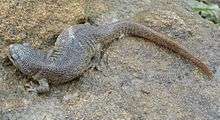Algerian ribbed newt
The Algerian ribbed newt (Pleurodeles nebulosus) is a species of salamander in the family Salamandridae found in Algeria and Tunisia.[2] The natural habitats of this newt are rivers, intermittent rivers, swamps, cisterns, freshwater marshes, intermittent freshwater marshes, and ponds. It is threatened by habitat destruction.
| Algerian ribbed newt | |
|---|---|
 | |
| Wild Pleurodeles nebulosus in Tunisia | |
| Scientific classification | |
| Kingdom: | Animalia |
| Phylum: | Chordata |
| Class: | Amphibia |
| Order: | Urodela |
| Family: | Salamandridae |
| Genus: | Pleurodeles |
| Species: | P. nebulosus |
| Binomial name | |
| Pleurodeles nebulosus (Guichenot, 1850) | |
Taxonomy
Formerly, this species was confused with Pleurodeles poireti. Carranza and Wade (2004)[3] found out that most North African Pleurodeles species that had previously been referred to as P. poireti were in fact Pleurodeles nebulosus, an altogether different species. The true P. poireti newts are found only on the Edough Massif, in northeast Algeria.[1]
Description
The Algerian ribbed newt is a medium-sized species growing to a length of about 23 cm (9 in). The head is flattened and has small eyes and a rounded snout. The body is somewhat flattened and the tail of the male is longer than that of the female. In the breeding season, fins grow above and below the tail. The colour is olive-brown above blotched with darker patches, the flanks are yellowish and the underparts are pale grey, often with darker spots. The skin of the upper parts is very granular.[4]
Status
The Algerian ribbed newt has a restricted range in northeastern Algeria and western Tunisia. It lives and breeds in freshwater habitats such as marshes, ponds, streams and cisterns. The main threats it faces are pollution of its environment and habitat destruction as the land is put to greater agricultural uses, especially increased grazing by livestock. The International Union for Conservation of Nature has assessed its conservation status as "vulnerable".[1]
References
- Donaire-Barroso, D.; Salvador, A.; Tahar, S.; El Mouden, E.H.; Geniez, P. & Mateo, J. (2006). "Pleurodeles nebulosus". IUCN Red List of Threatened Species. 2006: e.T61919A86178127. doi:10.2305/IUCN.UK.2006.RLTS.T61919A12572868.en.{{cite iucn}}: error: |doi= / |page= mismatch (help)
- Frost, Darrel R. (2014). "Pleurodeles nebulosus (Guichenot, 1850)". Amphibian Species of the World: an Online Reference. Version 6.0. American Museum of Natural History. Retrieved 22 February 2014.
- Carranza, S.; Wade, E. (2004). "Taxonomic revision of Algero-Tunisian Pleurodeles (Caudata: Salamandridae) using molecular and morphological data. Revalidation of the taxon Pleurodeles nebulosus (Guichenot, 1850)" (PDF). Zootaxa. 488: 1–24. doi:10.11646/zootaxa.488.1.1.
- Max Sparreboom (2014). Salamanders of the Old World: The Salamanders of Europe, Asia and Northern Africa. BRILL. p. 304. ISBN 978-90-04-28562-0.
